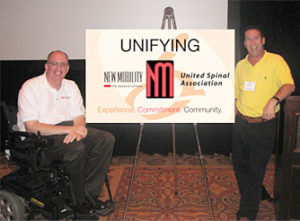By Joan Leotta

Paul Tobin (left) of the United Spinal Association and Jeff Leonard of New Mobility celebrate the joining of their two enterprises.
For more than 20 years, Americans with disabilities and their families and friends have come to rely on New Mobility magazine for news and features of interest to their community. The first-of-its-kind lifestyle magazine for people with mobility issues, New Mobility remains the leader in its niche. Now, in a move designed to strengthen the magazine’s role within the community, New Mobility will join forces with United Spinal Association to improve the daily life and outlook of those with mobility impairments.
Paul J. Tobin, president and CEO of United Spinal Association, says that as a result of the acquisition, both entities “will simply be in a better position to support each other’s efforts and continue to serve those who are mobility disabled.” SaysNew Mobility publisher Jeff Leonard and CEO of Leonard Media, “The new whole will be greater than the sum of the individual parts.”
New Mobility grew from a few thousand subscribers to a readership of almost 20,000 subscribers under its ten-year affiliation with Leonard Media. Similarly, United Spinal Association developed from a small Veterans’ group of around 2,000 in the 1940s to a 12,000-member organization with a presence in all 50 states and a program of services that includes publications as well as advocacy.
New Mobility: Past and Present
New Mobility started in 1989, the brainchild of Sam Maddox, a writer and professor at the University of Colorado. Maddox’s vision was to encourage active choices among wheelchair users. Maddox soon recruited writer/filmmaker Barry Corbet as founding editor. Corbet helped establish the magazine’s unique voice and focus. Although Corbet passed away in 2004, Maddox still writes for the magazine occasionally, and early intern Jean Dobbs still works as an editorial director.
Tim Gilmer, who took over editorship ten years ago, explains: “Whereas other publications in the disability community focused on advocacy, New Mobility, since its inception, focused on lifestyle.” Yet, though advocacy isn’t the magazine’s main goal, in its own way New Mobility encourages positive perspectives on people with disabilities. Gilmer notes, “Barry used to say that there is power in lifestyle. He felt that the magazine…is in the business of showing as well as telling.”
New Mobility aims to provide readers with stories on topics such as disability culture, travel, health issues, useful products, and unique profiles that avoid hyperbole. “In this way,” explains Gilmer, “the stories present real situations and not unattainable fantasies.” For example, the May 2010 issue described the mountain-climbing experiences of quadriplegic Steve Muse. The story avoided leaning toward the heroic by stressing Muse’s pre-injury passion for climbing and his willingness to accept help. Muse retrained himself in new techniques and the use of adaptive equipment to become the first quad to climb Yosemite’s El Capitan via the Zodiac route.
Says Gilmer, “The article is a good model for how to show that no matter what, anyone can rise to the top by taking advantage of the environment and equipment, seeking assistance, and working hard.”
New Mobility does about fifty or sixty feature stories a year, and while most are well received, Gilmer notes that readers are also quick to relay their displeasure with stories they do not like. The February “Sex, Wheels, and Relationships” issue attracts “visceral positive and negative responses from the readership, including a few calls to discontinue subscriptions,” Gilmer says. He admits that some of the cover shots are too racy for homes with children or for doctors’ offices, but notes that the issue matches the magazine’s main goal. “We try to cover every aspect of the disability lifestyle,” he explains, “and sex and relationship issues are as relevant for wheelchair users as for other people.”
The magazine’s role as a lifestyle publication has garnered numerous recognitions not only within the disability community but also among mainstream publications. Says Gilmer, “Of all the awards we have received, the one of which I am most proud is the 2006 Utne Reader Independent Press Award for Best Lifestyle Coverage.”
Future
New Mobility’s partnership with United Spinal is fueled in part by both entities’ common interest in issues that affect the wheelchair community. For example, with their combined political clout, both hope to witness improved access to power wheelchairs, further refinement of lightweight manual wheelchairs, and improved seating systems and other assistive technology.
Leonard looks at the joint operation as a logical progression of his company’s work on behalf of people with mobility disabilities. “The original mission of Leonard Media was all about product,” he explains. “Then, with New Mobility magazine as part of the group, the mission became more about voice for empowering the individual and providing information on all aspects of the reader’s lives. Now the mission is expanded to include public policy access.”
Tobin adds, “New Mobility will remain a stand-alone publication. I have worked with Jeff Leonard over the years on such issues as medical equipment accessibility and Medicare payment policies—everyday life issues.” But now, by writing letters to the editor in New Mobility, explains Tobin, “individual readers will have another avenue to communicate their policy concerns—concerns that we will then use to guide our policy initiatives straight from the community.”
Edited by Mary-Louise Piner.
Leave a Reply
You must be logged in to post a comment.